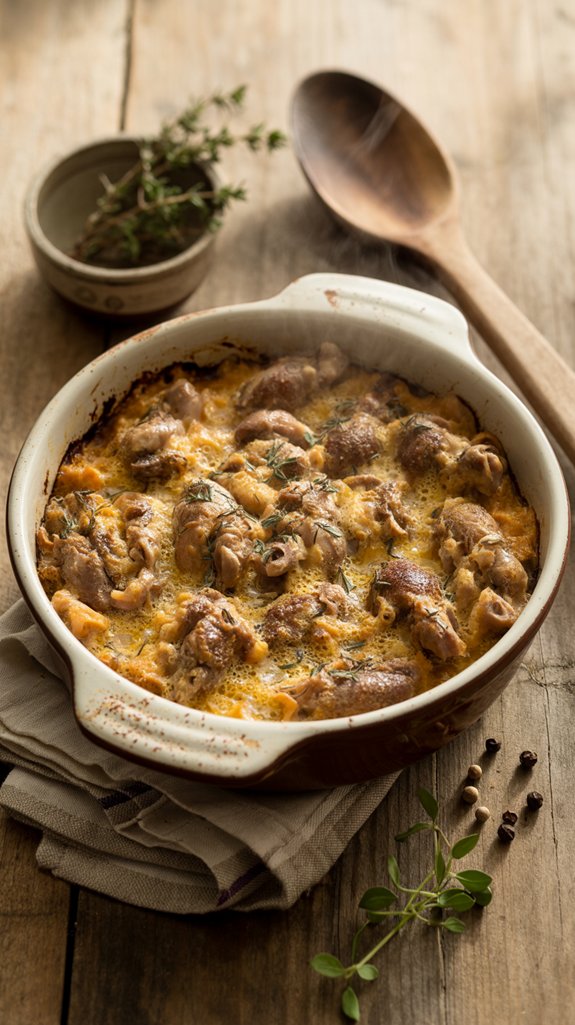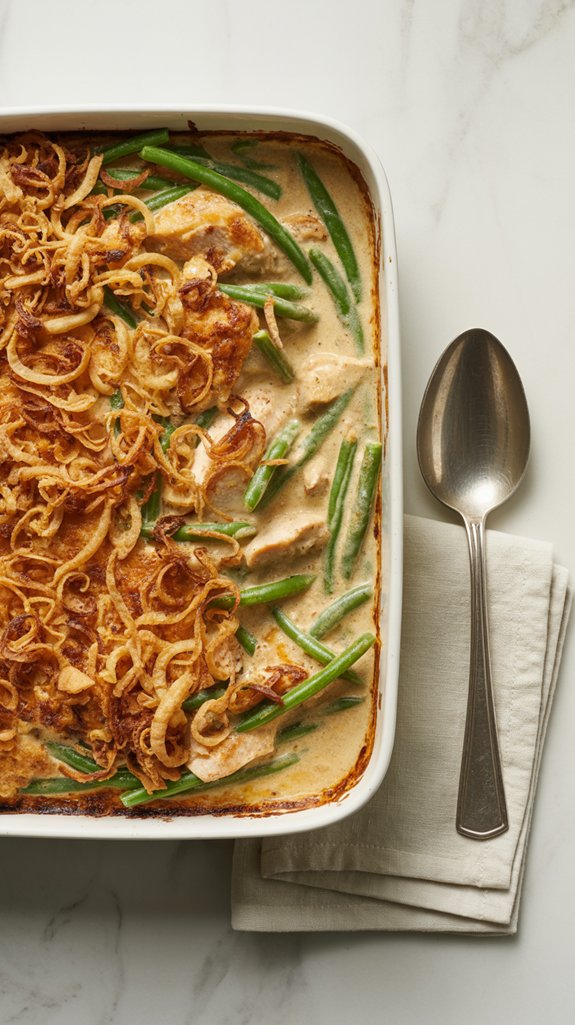Why You’ll Love This this Hearty Chicken Gizzard Casserole
This slow-simmered gizzard casserole transforms those often-overlooked chicken parts into something absolutely tender and flavorful, proving that the best comfort food sometimes comes from the most unexpected places.
The rich, wine-kissed tomato sauce gets plenty of time to work its magic on those tough little muscles, turning them into fork-tender bites that’ll make you wonder why you’ve been tossing these gems aside.
Whether you serve it over rice, buttered noodles, or get adventurous with quinoa, this hearty dish delivers that soul-warming satisfaction you crave on a brisk evening.
Ingredients List
Getting this hearty casserole on the table starts with gathering some simple ingredients that pack a serious flavor punch.
- 2 lbs chicken gizzards
- 2 tablespoons olive oil
- 2 tablespoons butter
- 2 onions, sliced
- 4 garlic cloves, minced
- 1 cup white wine
- 1 cup tomato sauce
- 1 tomato, seeded, peeled, and chopped
- 1 teaspoon salt
- Pepper, to taste
- 1/2 teaspoon oregano
- 1/2 teaspoon thyme
- 1/2 teaspoon marjoram
- 1/2 teaspoon rosemary
- 1/2 cup chicken broth
- Chicken gizzards are surprisingly lean and packed with protein, making this dish heartier than you might expect
- The combination of olive oil and butter gives you the best of both worlds – healthy fats plus that rich, buttery flavor
- White wine adds depth without adding many calories, and most of the alcohol cooks off during that long simmer
- Fresh herbs bring antioxidants to the party, though dried herbs work just fine if that’s what your spice rack provides
- This recipe naturally fits into low-carb eating plans when you skip the noodles and go with cauliflower rice instead
Step by Step Directions

This slow-simmered casserole transforms tough chicken gizzards into tender, flavorful comfort food through patient browning and gentle braising.
- Brown the 2 lbs chicken gizzards in olive oil and butter in a large, heavy-bottomed pot or Dutch oven over medium-high heat.
- Add sliced onions and minced garlic to the pot and brown them with the gizzards.
- Pour in white wine and tomato sauce, stirring to combine, then cook for 2 minutes.
- Add the chopped tomato, salt, pepper, oregano, thyme, marjoram, and rosemary.
- Cover the pot and simmer for 1½ hours, allowing the gizzards to begin tenderizing.
- Add chicken broth and continue cooking covered for another 1½ hours until the gizzards are fork-tender.
- Serve hot over rice, buttered noodles, or your preferred grain.
For those who prefer oven cooking, a professional roasting pan set can provide excellent heat distribution for similar braised dishes that require long, slow cooking times.
Substitutions and Variations
• Vegetable additions – Carrots, celery, or mushrooms added with the onions bulk up the dish and sneak in extra nutrition.
Bell peppers work too, though they’ll soften considerably during that long simmer.
• Different proteins – Chicken hearts can join the gizzards, or you could use this same method with tough cuts like chicken thighs or even pork shoulder, adjusting cooking times as needed.
Additional Things to Serve With This Dish
This rich, savory casserole begs for sides that can soak up all that wonderful sauce you’ve been simmering for three hours.
• Classic starches – The recipe mentions rice and buttered noodles for good reason, though I’m partial to wide egg noodles that can really grab onto that sauce.
Mashed potatoes work beautifully too, especially if you make them a little looser than usual so they can mingle with the gravy.
• Crusty bread options – A good sourdough or French bread for dipping is practically mandatory, unless you’re one of those people who doesn’t mind leaving perfectly good sauce on the plate.
Cornbread brings a slightly sweet contrast that plays nicely with all those herbs.
- Simple vegetables – Green beans or roasted Brussels sprouts add color and cut through the richness, though honestly, after three hours of cooking, you mightn’t have energy for much more than opening a bag of frozen peas.
- Grain alternatives – Quinoa, as the recipe suggests, or wild rice if you want something with more texture and earthiness.
Barley works too, though it takes forever to cook, so plan accordingly.
Cooking Tips & Tricks (Chef’s Notes)
Three hours of cooking time teaches you a few things about patience and chicken gizzards.
• Don’t skip the browning step** – I know it’s tempting to dump everything in the pot and call it a day, but those caramelized bits from properly browning the gizzards and onions are what separate good gravy from great gravy**.
Take your time here, even if your kitchen starts smelling like a French bistro and making you question your dinner timeline.
• Keep the simmer gentle**** – High heat turns gizzards into rubber bullets faster than you can say “what went wrong.”
You want barely bubbling, the kind of lazy simmer that makes you worry nothing’s actually happening, but trust the process.
• Test for doneness the old-fashioned way – Fork tender means fork tender, not “well, it’s probably close enough.”
Gizzards are stubborn little muscles that need every minute of that three-hour commitment, though some batches finish earlier if you’re lucky.
• Wine matters, sort of – Use something you’d actually drink, not the cooking wine that’s been lurking in your pantry since 2019.
That said, this isn’t the time to crack open your good Burgundy either, unless you’re feeling particularly generous with your grocery budget.
• Make extra sauce** – The ratio of sauce to gizzards always seems perfect until you start serving, then suddenly everyone’s fighting over the last spoonfuls of that herb-infused goodness** you spent half your day creating.
Nutritional Facts
This hearty casserole packs surprising nutritional value beyond its rich, satisfying flavor.
- High protein powerhouse – Chicken gizzards deliver about 30 grams of complete protein per serving, making this dish a serious muscle-building meal that puts most chicken breast recipes to shame.
- Iron-rich remedy – One serving provides roughly 25% of your daily iron needs, perfect for anyone dealing with fatigue or looking to boost their energy levels naturally.
- B-vitamin bonanza – Loaded with B12, niacin, and riboflavin, supporting everything from brain function to healthy skin, though your dermatologist probably won’t prescribe gizzard casserole specifically.
- Zinc for immune support – Each portion contains significant zinc levels, helping your body fight off whatever’s going around the office this season.
- Low in saturated fat – Despite the rich taste and butter in the recipe, gizzards are naturally lean, keeping the saturated fat content surprisingly reasonable.
- Selenium source – Provides antioxidant benefits that help protect cells from damage, though you’re probably eating this for the comfort factor rather than the anti-aging properties.
- Moderate calorie count – Approximately 320-380 calories per serving (depending on portion size), making it hearty without being excessive when served over rice or noodles.
- Sodium awareness – The wine, tomato sauce, and added salt push sodium levels higher, so go easy on additional seasoning if you’re watching your intake.
Fun “Did You Know?”
Beyond all those impressive health benefits, chicken gizzards carry fascinating stories that’ll make your next dinner conversation way more interesting.
Did you know gizzards are fundamentally muscular stomachs that grind food since chickens don’t have teeth? They’re packed with tiny stones and grit that chickens swallow to help digest their meals.
In many cultures, gizzards are considered delicacies – from French confit to Japanese yakitori.
Here’s something wild: a single gizzard can contract over 3,000 times per hour! That’s why they’re so incredibly tough and require long, slow cooking to become tender and flavorful.





